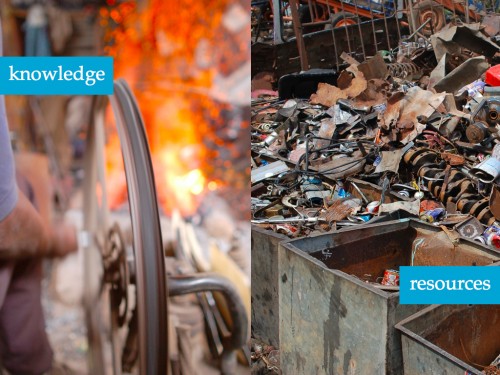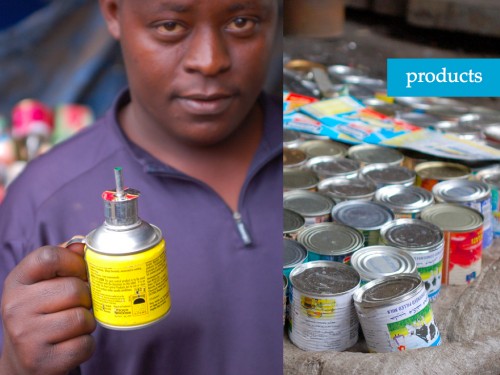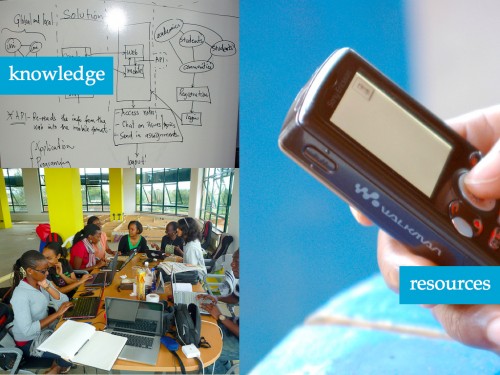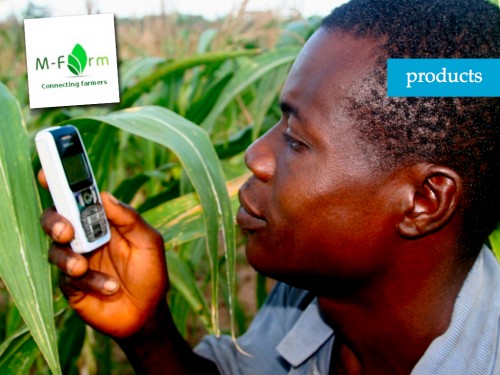I gave a keynote yesterday at the opening of the infoDev Global Forum in Helsinki, which has a specific focus on innovation. The m:lab funding comes from them, and they are exploring new ways to help entrepreneurs in the high-tech space, specifically mobiles, to make their businesses a reality.
Innovation: Knowledge and Resources
I’ve already stated that I think innovation is spread equally across the world. No one region has a monopoly on it. The kind of innovation that you see is dependent upon a number of things, but the foremost in my mind are knowledge and resources.
It’s what you’re educated about and in, it’s your skills, training and ability. When you mix that with the resources available around a creative and inventive person, then innovation happens. Let’s take a look at it.
Low-tech example
In Gikomba, a market place of jua kali workers in Nairobi, you find that their resources are made up of re-usable metal and they have deep training in non-traditional metal working methods and tools.
It comes as no surprise then, that the products they create look like this. Parafin lamps and other low-tech consumer products that sell cheaply and yet took a good deal of local ingenious thinking to craft (originally).
High-tech example
There is a group of women coders in the Nairobi area that call themselves the Akirachix. They often work out of the iHub, and their knowledge is about PHP, MySQL, USSD and SMS application building. The resources around them are mobile phones, and computers to work with.
It comes as no surprise that a couple of these gals (Jamila and Susan) develop mobile and web applications, targeted towards a demographic that they understand: farmers. M-Farm is a USSD and SMS app for farmer information, and organized buying by coops and suppliers.
What you see
What’s interesting here is that it’s often difficult for someone coming from one society and cultural background to appreciate the level of innovation coming from a completely different one. I used a couple examples of this in my discussion yesterday. How the low-tech innovation that we see at Maker Faire Africa is still innovation, and they have business value and provide efficiencies to the community that created them.
What’s difficult for people to do is see. It’s hard to look through another set of lenses and appreciate the inventiveness that got something so far. It’s a challenge to understand the needs of a culture that you don’t share and then create a product for it. This is why so many of the platforms and products designed in the West fail in Africa. It’s not that they’re not well designed, they’re just not designed by people who truly understand the needs of the customers in Africa.
It’s why rugged and efficient seed planting devices will be created in rural Ghana. It’s why Ushahidi and Mpesa had to come from a place like Kenya. It’s why South Africa’s Mxit has 35m users.
Finally, it’s why we should continue to invest in local inventors and entrepreneurs – instead of importing foreign solutions, let’s grow our own.




May 31, 2011 at 10:13 am
This is impressive an article and indeed a timely discourse.Well done!
May 31, 2011 at 11:11 am
Great post Erik! Totally agree. I had a new insight into this issue recently thanks to an Econtalk podcast with Tim Harford talking about his new book Adapt. Not only is local innovation important, it is more important than ever because it is naturally more adaptive than large systems. We can’t afford large monolithic solutions any more because when they fail, they fail catastrophically as we saw with the global financial meltdown or with the Fukushima reactor. Local innovation is important because it is naturally adaptive and can fail safely. We need policies that encourages local experimentation and provides incentives for people to replicate success as opposed to wholesale policies that may or may not be the right answer in the end and may take a generation to correct if they do fail.
May 31, 2011 at 1:25 pm
I like this paragraph: “What’s difficult for people to do is see. It’s hard to look through another set of lenses and appreciate the inventiveness that got something so far. It’s a challenge to understand the needs of a culture that you don’t share and then create a product for it. This is why so many of the platforms and products designed in the West fail in Africa. It’s not that they’re not well designed, they’re just not designed by people who truly understand the needs of the customers in Africa.”
It’s an inspiring comment for an inspiring post. I love the examples you provided! It feels good to read successful stories as the ones you referred to. I think the best way to help people is to be with them on a daily basis. A formula applicable in a part of the world won’t necessarily be succesful in another part of the world. Keep the good work! Jessica 🙂
June 1, 2011 at 4:43 pm
Nice article Erik, i like the way you have made the story flow from the gikomba innovator to the akirachix innovation, images communicate alot also.
Secondly, as you said, innovation cannot be localized to a cliche, its global and has to provide solutions to the local people for all of the globe, and who is best suited to tackle this? We all know that, the innovators from the said area.
June 1, 2011 at 4:50 pm
Applause!Applause,Applause!! The creativity and innovation is specific and unique also to a community within Africa..recently the Mobile money platform M-Pesa failed to live up to Vodacom’s expectations for the product in SA, group’s CEO, admitted. Vodacom registered “more than†100 000 M-Pesa users in SA since its launch in August 2010, but this is short of its expectations.
June 1, 2011 at 5:14 pm
I agree. “Let’s grow our own.” Right here, right now.
It is because of people like you that I am proud to be part of the Kenyan technology community. You have no idea how many tech CEOs have asked me what the iHub is and I tell *them (I used spell check this time :] ) to just go see for themselves, so they come and get the shock of their lives.
Keep up the good work!
June 1, 2011 at 9:13 pm
Great article. Wonderful insight. A solution comes from within. Let resources focus on the local apps tht have a better approach to the people they relate to on daily basis, and understand the problem and the system
June 2, 2011 at 1:07 am
Guess its also time we encouraged our own to do biz a little differently. I do agree, its difficult to see, but to compound that is the difficulty to run with a solution should it be visible – rigidity in how solutions should be curved out and implemented. We are always reminded capital is hard to come by. True. But in this day and age, we should encourage our innovators with the fact that the first step to build something shouldnt always be coz there wasnt money to put in. Funding comes when an idea is well packaged and some motion is visible. Then it simply fuels an idea that was and its not really the starting ignition. Should we say “one derivative of innovation = innovation”. Innovating on ways to bring an innovation to life. Several small creative ways to bring life to the big idea. Sounds like the scarcity of a resource triggers innovation by leaving very few options forcing use of alternatives that were never quite thought of. Also, I wonder what it took, more than time, to bring the skeleton of the M-Farm idea (and many others) to bare life. Funding was later. Time and the relevant know-how then, are great resources; one that lots of us may have in our hands.
I want to suggest that availability and/or lack of resources are both important to a certain degree to spur innovation locally. How one plays them is very dependent on knowledge. My two cents quick thots….
June 6, 2011 at 2:30 am
This is brilliant Erik! It makes me think of the toolboxes used by truck drivers in Guinea-Cote d’Ivoire-Liberia: one wrench, a plastic bag, some twine and an empty plastic bottle. Also the souped up Land Cruisers in Somalia and northeastern Kenya that never enter a TOYOTA garage for servicing but can operate on the worst roads. The points you make are brilliant but unfortunately the ability to see lessens the more educated and sure we are of our evangelical mandate to rescue the poor.
June 9, 2011 at 5:49 am
Right on! Unfortunately those of us from the West who live here often play along in the game of rescuing poor Africa, a game perpetuated by both the West and citizens of Africa as well. We need to think less as providers, and more as advisers. Because of the tremendous inertia from the past, this is a difficult ship to turn.
June 22, 2011 at 3:34 am
great piece! very true.
its important that we appreciate and encourage our own solutions.
we need more of this type of articles to help change our thinking as Kenyans. to look for our own solutions and become our own greatest fans; support our own.
when it just came out, it was hard to believe that m-pesa is 100% kenyan! we need to shift our thinking to believe in ourselves!
this is a great piece.
July 5, 2011 at 4:26 am
This is an interesting article more so the fact that innovation has its foundation in knowledge and resources. Consider a country like South Sudan where natural resources are in abundance (in the most natural form), the knowledge bit is sketchy at best owing to 50 years of war then innovation based on knowledge and resources becomes a bigger challenge; however, innovation need not be universal – driving around Juba you notice small innovations which often makes me wonder whether your very circumstances actually informs your inventive thought and processes.